The year was 1999, the month was May, and Newsweek (an American weekly news periodical) had a cover feature entitled “What You’ll Want Next”. The cover prominently featured a Sega Dreamcast controller (the console was slated for U.S. release a few months later). One of the features in the issue had an illustration of a future home and all the technological marvels that would arrive in coming years. I scanned the pictures and always wanted to write something about the prognostications contained within, some of which seemed a tad outlandish.
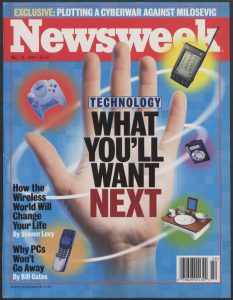
May 31, 1999 Newsweek magazine: “What You’ll Want Next” (cover found at: Yale Library Digital Collections)
I never got around to it at then (plus, I had no good place to publish it). But look at the time– it’s 10 years later already! And I still have the page scans laying around, having survived moves to at least a 1/2 dozen “main desktop computers” over the intervening decade. So let’s have a look at where we were supposed to be by now.
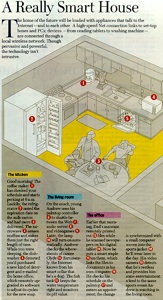
|
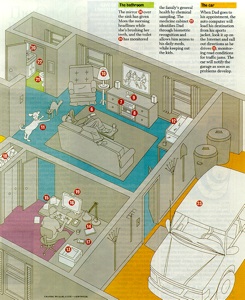
|
Click for larger images
A Really Smart House
The home of the future will be loaded with appliances that talk to the Internet — and to each other. A high-speed Net connection links to set-top boxes and PCs; devices — from reading tablets to washing machine — are connected through a local wireless network. Though pervasive and powerful, the technology isn’t intrusive.
Pretty high level and fairly reasonable so far, although I don’t think those Tablet PCs ever took off. Network connected washing machines? Come to think of it, I do remember reading about such machines in The Daily WTF’s Laundry of the New Millenium. Did anything of the sort ever make it into the consumer space? I did some impromptu searching for “washing machine connected to network” and similar searches and found numerous geek hacks to achieve the effect. However, I also found an article about such a device called the LG Turbo Drum, published only a year after this article. Further searches on that topic seem to confirm that it’s a real consumer product.
What is the point of having a network connected washing machine in the first place? The best that the previous article can state is that the washing machine can connect to a master server and keep up to date with the correct programs for washing certain types of fabrics. “Unlike current machines, which have a fixed number of wash programs,” states the article. Every washing machine I have ever encountered in my life basically has “hot” and “cold” settings; I never thought of those as “programs”, but okay.
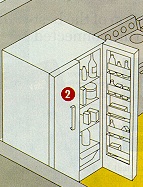
The same article mentions LG’s earlier network connected refrigerator. This is convenient, because the Newsweek graphic also mentions the fridge of the future. In fact, this is the item about the entire article that had always stuck in my head, in particular, “the refrigerator noted the expiration date on the milk carton and had more delivered.” That sort of made my head pop when I first read it 10 years ago. I couldn’t conceive of how it could even be possible for the milk carton and the fridge to communicate. But I had never heard of RFID at the time, either. I remember much being made of RFID eariler in the decade, particularly something about Wal-Mart wanting to deploy it on a wide scale for inventory control. I haven’t heard much about it lately, but I’m pretty sure that we don’t yet have RFID tags embedded in every consumer item purchased.
Just today, I read a humorous article about 6 inventions that were supposed to change the world but didn’t really pan out. #3 on the list was online delivery for everything. I bring this up because reading the milk prediction made me wonder how this could possibly work. It turns out that several companies tried very hard to make a go of this — delivering anything you wanted and doing it in under an hour. They were probably excited to see this Newsweek piece. But it’s not enough to have a bunch of cables in place relaying digital information. Somewhere along the line, there needs to be a physical transfer of materials– someone needs to deliver and someone needs to be at home in order to receive. In the graphic’s scenario, how does the milk just “get delivered”? Perhaps this refers to a modernization of the old-time morning milk delivery services? Somehow, I got the impression that this service would be a bit more general.
Okay, that’s enough about the milk. Let’s talk about the coffee:

The coffee maker has checked your schedule and starts perking at 6 a.m.
I grew up in a household in the 1980s that had a timer device which achieved the same effect– I guess it just allowed electrical current to flow starting when the clock struck the appointed time. I suppose the coffee timer in the article is an incremental improvement over that model. It could be controlled via wireless from a centralized app that understood your dynamic, varied schedule.
Did such a contraption ever come to be exist in the past 10 years? Same as with the network-connected fridge, searches for the network-connected coffee maker produce numerous custom hacks to achieve the same effect. There is however, a beast named the Jura-Capresso Impressa F90. Amazon has the F9 model for sale but its specs do not mention network connectivity. It’s possible that the F90 model has been disavowed and disowned due to remotely-expoitable buffer overflows.
As a brief aside, I recently heard a presentation about the “computer as appliance” metaphor often referenced when describing the level of easy usability to which designers hope to elevate computers. One joke tossed around was: A refrigerator appliance doesn’t need a patch to remain secure; a software appliance does. That might not be true with FutureFridge(TM) and FutureCoffeeMaker(TM).
Moving on to items 4 and 5 from the graphic:
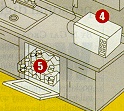
The microwave senses muffins and nukes them just the right length of time. While you were sleeping, the dishwasher detected you’d purchased a new kind of detergent and e-mailed the home office, which remotely upgraded its software to adjust its cycles for the new soap.
So, it seems that you still need to manually place the muffin in the microwave. This prediction merely conjectures that the microwave will be smart enough to detect what you have placed within and heat it appropriately. Would such a microwave also prevent numerous YouTube videos of people experimenting with “nuking” all manner of non-food materials?
The dishwasher scenario seems like a huge stretch. How useful could this possibly be? What problem is this solving? Is incompatible dish detergent a huge consumer debacle? Then we get into the engineering issues: What if there are network problems? Worse, what about remotely exploitable buffer overflows in the dishwasher firmware? What could a remote attacker do to your kitchen after taking over your dishwasher?
Wow! That was just the kitchen. Fortunately, the living room predictions are a good deal more plausible:

On the couch, young Andrew uses his palmtop controller to shuttle between the Web, audio server, and videogames. Later, the lamp will turn on automatically. Andrew checks the whereabouts of canine Clyde… The fish tank keeps the water temperature right and monitors its pH value.
The first part — regarding the WWW, audio server, and videogames — is surely possible today using a number of solutions (I believe all 3 major video game consoles today can serve those 3 functions by themselves; a reasonably tech-savvy individual can easily concoct their own solution). The smart collar sounds doable, though its utility is questionable. How would it track your pet? How would it present its location to you? I searched for smart collars but mostly just found shock collars for invisible pet fences.

About the aquarium pH monitor, that feels like technology for technology’s sake. I’m no fish enthusiast, but my understanding is that fish owners have had this pH thing locked down for years now without any overblown digital technology. I wouldn’t be surprised if the last decade saw incremental improvements in pH monitoring devices. But is a network-connected device really that useful in this domain? That’s not really for me to ask, I suppose. A little searching produces the Neptune Systems AquaController Pro (Aquarium Controller & Monitor) for pH, mV (ORP) and Temperature. Features include “PC or Macintosh RS232 Serial Interface, Ethernet Interface (10 Base T), Embedded HTTP Web Server, and Telnet Server”.
The section on home office predictions starts out fairly sane:

Earlier that morning, Dad’s assistant remotely printed out files while he scanned newspapers on his digital tablet.
Fine. I’m pretty sure the technology to remotely ask a printer to do its job was quite mature back in 1999. And while Newsweek may have been a tad optimistic about the future of traditional newspapers (which are notably dropping left and right in the U.S.), certain papers have been diligently pursuing better digital experiences (such as the New York Times with its new Adobe AIR-based reader). Indeed, the strangest thing about the foregoing excerpt is that the assistant would print documents when they could (presumably) be downloaded and consumed via the tablet on which Dad is perusing the day’s news stories.
I guess if they didn’t mention printing the vital documents, then they wouldn’t be able to mention this outlandish idea:
Now he puts a smart staple on [the printed documents], which links the files to documents in his own computer.
Huh? What on earth for? Searching for “smart staples” produces nothing relevant to this particular far-out use case. Moving along…
He checks his schedule on the palmtop and enters an appointment; the change is synchronized with a small computer woven into the sports jacket he’ll wear later in the day.
Wearable computing; has that taken off in any appreciable way? How do you clean clothing that contains embedded electronics?
His video camera detects that he’s restless and provides him some entertainment: a feed to the same sports event Andrew is watching in the living room.
So, the computer will intelligently decide when you need a break from your work for some entertainment. I don’t know about you, but over the last 10 years, my computer has gotten plenty more distracting; I really don’t need my computer deciding that it’s time for me to quit concentrating on a programming project in favor of an entertainment feed I might enjoy.
Actually, I do remember having to do some work on someone else’s Linux machine once and he had a program in a similar spirit. It was a program that essentially locked the X session every 1/2 hour for about 30 seconds in order to force the user to take a break from working. I don’t work hard enough to merit such an intervention so the program got annoying fast.
All right, now we move into the bathroom. The mirror scrolls headlines (I’m pretty sure I’ve seen that in a movie, was it Total Recall?). The toilet monitors the family’s leavings to assess their general health. Both of those sound plausible and — maybe it’s just me — the latter sounds interesting. Here’s an article from 4 years ago about how such a toilet is real and supposed to be available, first to hospitals.
One more prediction for the bathroom:
The medicine cabinet identifies Dad through biometric recognition and allows him access to his daily meds, while keeping out the kids.
Again, is this a huge problem, kids indiscriminately sampling medications? Maybe, maybe not. But allow me to jump right into the worst case scenario– Dad is having some medical emergency that requires a quick fix of medication but A) the condition has temporarily incapacitated Dad and no one else has access to his meds; B) the medical emergency somehow alters the characteristics of the biometrics (Dad’s eyes change in a way that foils the retinal scan, perhaps?); C) the hardware or firmware of the medicine cabinet just flat out fails in any of 100 different ways and denies access to the life-saving medicine.
Plausibility-wise, I’m sure someone could make a go of the biometric medicine cabinet. Here’s a patent application on the matter.
One last area of the house, and it’s the garage:
When Dad goes to his appointment, the auto computer will load his destination from his sports jacket, look it up on the Internet and call out directions as he drives, monitoring road conditions for traffic jams. The car will notify the garage as soon as problems develop.
Most of that describes run-on-the mill GPS technology, mediocre by today’s standards but still gaining traction in the consumer space in 1999. The item about the car notifying “the garage” when problems develop is plausible enough that I could believe certain luxury brands have such a feature today. Then again, I see some problems and impracticalities. What is “the garage”? Corner mechanic? Original dealership? Closest authorized service center? And why would it be useful to simply notify the garage that there’s a problem? What can the garage possibly do with that information? Are they going to proactively call you and tell you that your car told them that you need to change your oil and rotate your tires? I realize that the “service engine” light found in numerous modern automobiles is a tad vague. But the alternative described in the graphic seems like a pendulum swing too far in the other direction.

It’s interesting to note that the automobile in the garage resembles a Toyota Scion or Honda Element. Prescient, considering neither were introduced until years after this article.
So that’s a dissection of the entire infographic. The first page has more written text from the main feature (reminder: “What You’ll Want Next”, written in 1999). This stood out:
A start-up company called emWare is readying a sprinkler system that checks out weather reports so it won’t spritz during a downpour.
You might be interested to learn that these days, http://emware.com/ proudly hosts a domain squatter. Let’s analyze the idea anyway. At this point, it’s starting to feel like the old “if the only tool you have is a hammer…” aphorism, and the only tool these people have is a TCP/IP stack. Is checking the weather report, i.e., checking estimations of future precipitation, really the best idea here? What if the weather report is consistently wrong (I know from whence I speak) and frequently predicts rain that rarely comes to pass? Off the top of my head, it seems like a better idea might be to have some sort of sensors (that aren’t connected to any kind of TCP/IP network, for goodness sake) in the ground that measure how much moisture has already been absorbed and gauge how much to water the lawn based on that.
So is it really fair to judge these items by whether a particular company or technology still exists 10 years later? Well, at the very least, if the technology was worthwhile, it should have provided a stepping stone to what is commonplace today. I enjoy watching a short film featured on MST3K called “Century 21 Calling” (attached to episode 906, The Space Children). Though produced in the early 1960s, it accurately mapped out telephone technology that would be arriving in the following 10-20 years including call waiting, call forwarding, and 3-way conferencing. To be fair, though, it also predicted that you would be able to call your house while away on vacation and activate your sprinkler system remotely. Since I don’t own a lawn, I have no idea if these watering dilemmas have been solved, but people have been thinking hard about them for over 40 years.
If you’re interested, Archive.org has the original Century 21 Calling short, though not the vastly more entertaining MST3K version (which you can probably find on YouTube).
One final note: Conspicuously absent from this vision of the future: robot servants. I wager the analogous article from 1979 would have prominently featured robots performing most domestic chores.
“You might be interested to learn that these days, http://emware.com/ proudly hosts a domain squatter.”
I think that sums up the article quite nicely ;-)
Around here the watering problem is still solved in the same way since ages: Ask the neighbours/friends/relatives to take care of it.
Even if such electronic devices existed, they would still be less reliable (which says more about the laughable reliability of any affordable electronics, particularly when combined with mechanics, than about the humans involved).
About RFID: at several cents a piece, it is still too expensive. But more importantly, last I heard having RFID (even if it can be disabled after purchase) is a reason not to buy it for the majority of people around here.
Conclusion: a lot of stuff never happens because, guess what, people actually do not want it.
@Reimar: That sort of undermines the title of the whole issue which was, “What You’ll Want Next” which, to be honest, I always found a tad patronizing (incidentally, the Sega Dreamcast, prominently featured on the cover, had roughly the shortest run of any video game console in the U.S.).
i would have told you about archive.org/web/*/emware.org but the domain squatters like robots.txt :(
wheres my damn flying car?
Wow, that’s pretty messed up– I never knew that a squatter had the power to wipe old versions of a site from the Archive.
For the purposes of this article, however, it’s enough just to know that the company is no longer in business.
Can’t you request the archive to backdate robots.txt requests only to a certain date? I am pretty sure there is a way to get around the “Squatter wipes out that site” problem. Fun look at it (thanks for doing such a absorbing article!), although 10 years ago, I must admit, there was the inkling of a lot of this technology already – at least the look of it, if not the exact functionality. :D
Also, do you mean “more entertaining *then the* MST3K version” at the bottom? Currently could be that you mistyped it entirely and meant it was more entertaining then the MST3K version or something? anyway, I’ll go watch it sometime, hehe.
Nope, I meant it as it was typed, which is to say that I think the MST3K version is vastly more entertaining than the original version (which is true for most things on MST3K and later on RiffTrax). “Vastly more entertaining” serves as the adjective in this case.
As for emware.com, compn is right (though he had the wrong domain). Check out http://web.archive.org/web/*/http://www.emware.com. Archive.org gives you nothing; they just point to the squatter’s robots.txt which contains:
It wouldn’t surprise me if the squatter blocks archive.org because the squatter gains no revenue from that bot (unlike search engine bots that are designed to drive users to ad-laden sites)
Personally, I think McNeally’s “Java lightbulb” was the funniest example. I can remember him talking about the Java CPU in the lightbulb predicting it’s imminent failure, then ordering it’s replacement over the Internet, noting that EMC customers don’t mind their multi-million-dollar disk arrays doing the same thing then (2001-2?) for failed disks.
Scott was a great guy and often a visionary, but sometimes he missed the scale differences. :) And let’s hope the lightbulb groks ipv6.
But back to the actual subject….
Lots of people underestimate the quantity of firmware running in modern whitegoods. Even a low-end washing machine, as one example, will have a few thousands of lines of firmware. High end units can have several megs.
My 1994 Fisher and Paykel has an 8-bit NEC CPU with 128K of ROM. The repair guys have access to service menus, which gives a lot of statistical info on how it’s been used. Washing weights, wash times, etc. A bit intrusive, actually. :) Watching this device deal with an unbalanced laundry load is interesting, as the unit detects excessive vibration, then goes through a bunch of different approaches to redistribute the load. You can see a significant amount of real engineering in how it works. More recent units from a number of suppliers have full LCD touch screens.
Moving on from washing machines, Freescale has a bunch of reference designs on microprocessor-controlled appliances, including a vacuum cleaner:
http://www.freescale.com/webapp/sps/site/prod_summary.jsp?code=RD68HC08VAC&parentCode=null&nodeId=0MFB28tn7z
Why do you need a microprocessor in a vacuum cleaner? Because it simplifies the motor design. A lot of microprocessors and low-end DSPs live hidden away near motors these days, because a direct-drive motor+microprocessor is cheaper than expensive mechanics.
Source code for the Freescale vacuum cleaner is on pp.37 through 58. I’d guestimate about 400 lines of actual C code in there.
But more generally, white goods are major users of household electricity and water. We’re all being told to use less of both, so having white goods which are aware of electricity and water tariffs makes a lot of sense. I just had a new power meter installed to support differentiated tariffing, so being the geek I am, I was surprised to find that it’s a Wi-Max unit which forms a network mesh across the suburb with all of the other units using a standard protocol. Having whitegoods and other power hungry household goods like hot water heaters joining the mesh to minimize cost/greenhouse gas emission seems to me to be a useful thing.
Of course, the security issues there are… interesting. And unsolved, right now. They’re soluble technically, but there are usability factors which are big challenges. Consider the number of complaints during the DTV transition in the US, where the people had obtained their STB, but had not realised that they needed to plug it into anything. Expecting someone with that level of idiocy – and I am sorry if people think I am being harsh but that is idiocy – to manage a mesh network authentication mechanism is unreasonable.
BTW, did you see the IEEE Spectrum article claiming that an average high end car now has 100M lines of source in it, running on 70-100 embedded microprocessors? See:
http://spectrum.ieee.org/feb09/7649
Yes, one hundred MILLION lines of code.
Oh yeah, and I also have a microprocessor in my toothbrush:
http://www.gizmag.com/go/5409/
:) :) :)
Ian.
PS. If technology predictions and failures really interest you, go and check out http://www.paleofuture.com. The site’s tag line says it all: “A look into the future that never was”.
PPS. One of the funnier lines I heard at the AUSCERT conference last month: “I’d get up at night, and I’d hear my fridge rebooting”.
Wow, Ian; and to think I was amazed when I first realized my car has a CPU in it (circa 1998). Thanks for the reassurance that there will be a market for embedded/real-time programmers for some time to come.
Thanks for the paleofuture site– that’s the kind of think I have always been fascinated with and will be spending a lot of time digesting it.